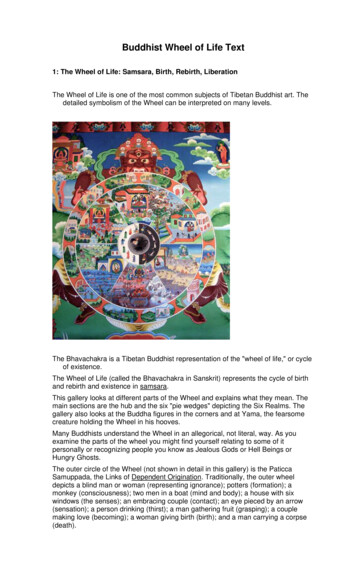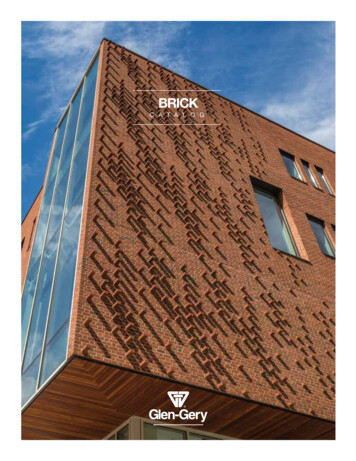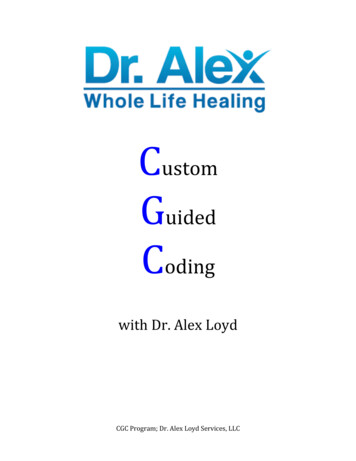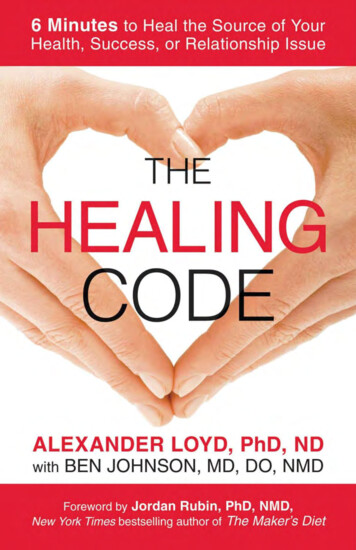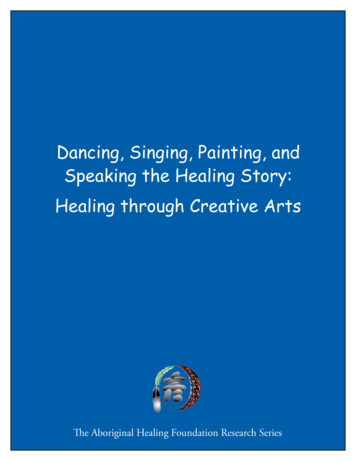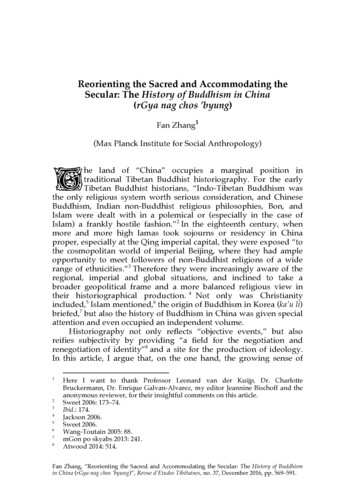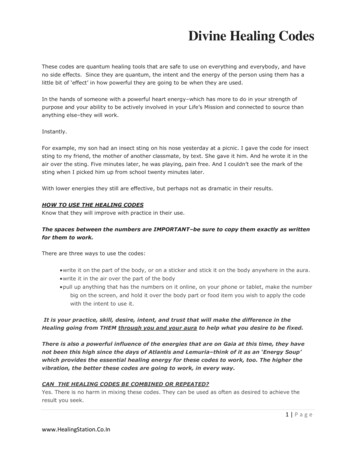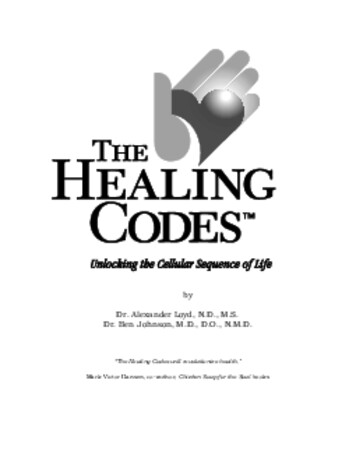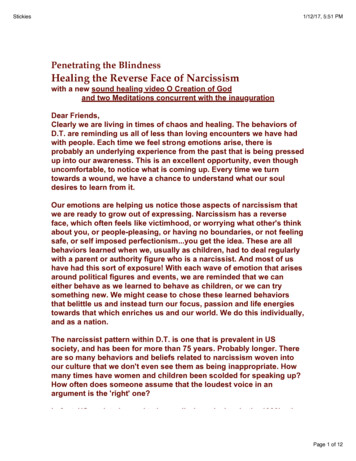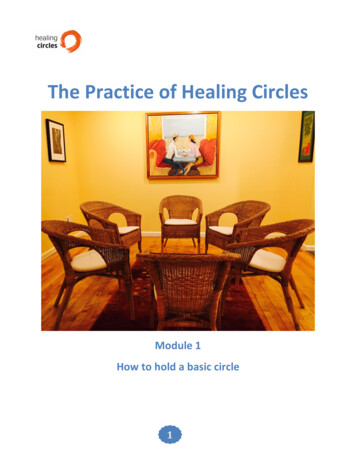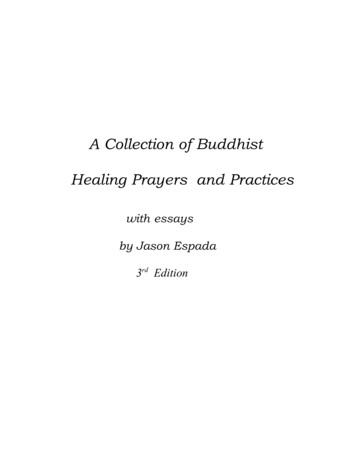
Transcription
A Collection of BuddhistHealing Prayers and Practiceswith essaysby Jason Espada3rd Edition
“It is said that whenever we practice Dharma it should always bepervaded by compassion at all times – in the beginning, in themiddle and at the end of our practice. Compassion is the source,the real essence of the entire path.”- Khenpo Appey Rinpoche
1Forward to the Second EditionA little over a year has passed since the first edition of this book wascompleted. Since then, I’ve been able to bring together a more Concise Setof Healing Prayers and Practices, of about 75 pages, based on that work. It’smy intention now to publish the Concise Set separately, and also to includeit here in this new edition, in it’s entirety.Comparing the first and second editions, I’ve made three more changes:First, I’ve taken some of the commentaries on healing practice that wereformerly in a later section, and incorporated those ideas into the openingsections, interspersed with an actual practice. For reference’ sake, the FirstEdition will continue to be available online.I’ve also written a few more essays and some poetry that I thought should beincluded in a second edition of this work.And, in gratitude, the list of websites and e-mail addresses of people andorganizations that accept prayer requests can now be found online, on ABuddhist Library, on the Things I Like to Share page. If there are anyquestions, I can also be reached via that website. Hopefully, the changesI’ve made will make this material easier to use.I truly hope as well that, in some small way, I have done justice with thiswork to the Noble Lineage of this practice. Where I’ve been mistaken, Ihumbly ask forgiveness for my impertinence. Whatever good is here is justthat good that is everywhere in the world, sometimes hidden, and thencelebrated when revealed, and the incomparable kindness and generosity ofmy teachers.A table of contents and two Prefaces follow.My warm best wishes to you all. May all beings benefit.
2Jason Espada, San Francisco, May 8th, 2010Forward to the Third EditionThis edition contains a few more essays, including a basic method ofmeditation, and a couple of brief commentaries, which I felt should be here,for completeness sake.As I continue to work with this material, it naturally changes, and thoserevisions are what I offer here. This is the best I can do right now.If I am blessed with more years on this earth, I will be very happy tocontinue to offer the best of what I find.May all beings benefit.Jason Espada, San Francisco, September 23rd, 2011.This edition was last revised on March 22nd , 2012.
3Table of ContentsForwardpage1Table of Contents3From the Preface to the First Edition8From the Preface to A Concise Set of Buddhist Healing Prayersand Practices13Part I: Introductory Prayers and Reflectionspage1. O, All my ten directions three times family222. All my family233. I live in this world24On Tonglen – Taking and Sending334. Taking and Giving Prayer – I355. Vow366. Taking and Giving Prayer – II387. a sun prayer428. a thorough going prayer439. By this practice44
4Table of Contents10. Such is the nature4511. Why don’t we48Part II: Selections from Various Medicine Buddha Sadhanasand Commentaries, with additional prayers1. Motivationpage 51On the form of the Medicine Buddha53On the Refuge Tree53Refuge, the Four Immeasurables, Special Intention,Refuge and the Bodhicitta motivation542. Requesting Prayers633. Instructions for visualization and mantra recitation684. Concluding practices72Dedication73On Tonglen81Part III: Material for reflection1. A list of things that are healing822. I believe in the power of the Buddhas and Bodhisattvas 96
5Table of Contents3. A Prayer to the Saints97Part III: Material for reflection, continuedTwelve Poems:1. Astringent and balm1052. This is what bodhicitta does1073. Parents praying for their children1094. Praise to All Healers1105. Help them first1196. Buddhism is not for those1217. Rain, O Rain1248. What will you gather from the mountain?1269. Oceans of gratitude12910. A Healing Poem13111. Good News for a Change13612. No place I’d rather be140
6Table of ContentsPart IV: Twenty four essays1. A few words on the art of contemplation1432. From a letter to a friend – on healing and strengthening ourselves 1513. A basic method of meditation, and two commentaries; 159Calm Abiding in Three Points1704. Going Beyond Loneliness - Applied Thought Training1725. The imperfect and the beyond perfect1846. On Ethics and Healing; In Praise of the Precepts1887. A few words on what is called purification in Buddhism1988. At some point you have to say yes2089. A Fully Born Human Beings21410. The Shadow from A Buddhist Perspective218Three Essays on Wisdom – Introduction23011. How going beyond ego-grasping reveals our True Nature,and why this is so important in Buddhism23212. An Introduction to Buddhist Wisdom Teachings236From A letter on Wisdom and Compassion250
7Table of Contents13. Key Points to the Great Middle Way25314. Why Compassion is the Most Important Thing in the World 25715. Regarding Tonglen26116. An Introduction to Buddhist Prayer26717. The Prayers of Contemplatives27818. On the Nature of Vow, and the Bodhisattva Vow28119. An Introduction to Mantra30420. The Foundational Refuge and Mahayana Refuge32221. The Power of Peace32822. On the Interaction of the Four Elements33423. Karma as Experience33824. Practicing the One Vehicle344Part V: Three Medicine Buddha Practice texts, The White Tara Sadhana,and a few additional mantras1. The Healing Buddha – A Practice for the Prevention and Healing ofDisease, composed and translated by Lama Thubten Zopa Rinpoche 3502. The Sadhana of the Medicine Buddha, by H. H. Dudjom Rinpoche 356
8Table of Contents3. A Stream of Lapis Lazuli363The White Tara Sadhana378A few additional mantras382Part VI: DedicationOn Dedication Prayer386Dedication Prayers390Recommended Reading412
9Preface IFrom the Preface to the First EditionFor me, the whole of religion in general, and Buddhism in particular can bethought of as having a healing function. From what I can tell, if twoconditions are present they can work to heal both the body and the soul, orthe inner life of a person.The first requirement for healing to be accomplished using the resources of aTradition is that a link be maintained with the deep sources of vitality thatcan be found in these Traditions. If it happens instead that the contemplativeaspect weakens, or if it becomes dissipated by too much intellectualization,or forced to the edges by a religion’s search for political power, then atradition can stop working for people.The second requirement for the healing values in traditions to continue towork in people’s lives is that we intelligently adapt the teachings as theyhave come to us. By ‘intelligently’ in this case I mean not changing themso much so that we’re just ‘winging it’, or ‘inspired by’ what has comebefore, but also not just repeating the way people from another culture andtime thought and practiced. If we do that then teachings then can take on anarchaic quality, and it can feel like they are not relevant to our lives as theyare now. It’s clear to me that we can and should adapt traditional teachingsso that they work for us.Hopefully both of these requirements will be met to some extent in thefollowing pages. May all beings benefit.May all beings be happy and at peaceand may their hearts be filled with joy
10Preface IA Note on the use of A Personal Sadhana, or, ‘Hanging all of Buddhistteaching on the peg of Medicine Buddha Practice’The following pages bring together a range of material on healing practices.In Tibetan Buddhism, healing can be accomplished through a number ofdifferent methods. For example, the practice of White Tara is excellent, andis something that I know from personal experience can be quite effective.Another of the healing methods from the Buddhist Tradition is the rich andwonderful practice of Medicine Buddha, and this is the framework I’ll use inthese pages.It should be noted that the preliminary contemplations included here, and theother thoughts for reflection, can stand alone as meditations in themselves,and they can also be used with other practices.For example, I’ve found that thinking along the lines of the article called‘I live in this world’ (starting on page 24) can be useful whenever I need toget my bearings, or to help me to set a strong, positive motivation.The ‘list of things that are healing’ (starting on page 82) is also something Irefer to often, edit and add to, and share with others whenever I can.Sometimes it’s a wonderful healing meditation just to sit with thesethoughts.As I write this (February of 2009) in regards to Buddhism, we are in a timeof transition. These teachings have been here in the U.S.A less than acentury, which is not a lot of time as traditions go. After a period ofreceiving the tradition as it was practiced, I feel we are just now beginning tomake these teachings our own. Without question, this is something we needto do.Rather than practicing Tibetan Buddhism, or Japanese style Zen Buddhism,understanding the principles involved, we need to see how these traditions
11Preface Irelate to our own culture and our own lives, and then work with them tocreate an our own Buddhism. This is how a tradition is able to take root andto continue effectively in another place. This is how it always has been, andhow it needs to be.In terms of the healing practices presented in the following pages, here thenis what I would propose:If it happens that practicing in the way I’ve outlined brings a result that isnot equal to or more effective than the traditional methods, then clearly thetraditional methods should be used instead of this one. On the other hand, ifusing a personalized set of reflections and prayers such as these produces aresult that is equal to or greater than the traditional methods, then this pointsin a useful direction for us to take.For comparison’s sake, I’ve included three complete traditional MedicineBuddha practice texts, as well as a White Tara sadhana, in section V.At this time there are also many excellent commentaries available on thetraditional way to practice these teachings.The word ‘Sadhana’ is sometimes used synonymously with ‘practice text’,as in ‘The Compassion Buddha Sadhana’, or ‘A Wisdom Practice Sadhana’.I’ve heard that the term itself means ‘method of accomplishment’, and it’swith this in mind that I’ve collected this material. We should use whateverworks for us.I would like to encourage others to bring together the reflections, prayers,selections from practice texts and commentaries that speak to them the most,and if this some or all of collection works for them, they are more thanwelcome to use it. Given our situation as human beings, and the sufferingthat exists in people’s lives, it is imperative that we be as compassionate andas skillful as we can.
12Preface IMay we all find and make full use of whatever methods actually removesuffering and bring happiness.A note on what is sometimes called magicSometimes the use of prayer, mantra, and visualization, and even the subjectof traditional healing is categorized as magic, which I have no problem with,if the term is used in it’s best sense. The word, unfortunately has been toooften associated with ignorance and superstition. At its best however, whatis called magic can be thought of as using subtle laws to bring about apositive result.The article on mantra, in Part IV, goes into this subject in more detail.May all beings benefit.Here is a general outline of what follows:Part I contains introductory prayers and reflections. As mentioned earlier,these can be meditated on separately, or they can be used in conjunctionwith any other practice.Part II has selections from various sadhanas and commentaries, with prayersand meditations.Part III has material for reflection. These can be used by themselves, orthese can be read before, interspersed with, or after, mantra recitationpractice. The reader is encouraged to write his or her own poetry andprayers, and lists of things that are healing. This section is more of asuggestion or a model for one way this be done. Of course, if these prayersare useful for you, you are most welcomed to use them.
13Preface IPart IV: Twenty three essaysPart V contains traditional practice texts for Medicine Buddha and WhiteTara, as well as a few additional mantrasandPart VI has dedication prayersHow to use this bookThis collection can be read straight through, and practiced with, but it shouldbe noted that parts I and II stand alone, and are meant to be usedindependently. To my thinking, the best way to approach a range ofmaterial such as this is to read and reflect on whatever is here that is usefulto you, or whatever you feel you need. These elements all fit together, andI’ve tried to be as complete as I can.If the general subjects of prayer in Buddhism, or the bodhisattva vow, ormantra are new to you, it may be helpful to read the essays in section IV onthose subjects first. These ideas are the foundation for healing in Buddhismas I understand it.
14Preface IIFrom the Preface to A Concise Set of Buddhist Healing Prayers andPracticesAlmost as soon as I finished A Collection of Buddhist Healing Prayers andPractices I thought it would be good to have a brief text that can be used fordaily practice, or that can be taken as a suggestion for another person whowants to draw together various prayers and practices for their own personaluse. I hope to offer in these relatively few pages a brief set of Buddhisthealing prayers and practices, that contain all of the essential practicalpoints.What I’ve come up with – ‘A Concise Set of Buddhist Healing Prayers andPractices’ is both published separately and included in this present volume,on pages 19 to 95, with the dedication prayers beginning on page 386.May all beings benefit.Why the Buddha is regarded as the Supreme Healer{and how this all fits together}To my mind, there are two reasons why the Buddha has been regardedthroughout time as the Supreme Healer:The first is that the Buddha saw not only suffering, but its causes as well,rooted in ignorance, and, from his very first talk, proposed a remedy to allsuffering. By developing the wisdom of insight into our own nature, theBuddha taught that we can become free from all karma and delusions, andall harm. This is a radical proposition that, over two millennia, many haveinvestigated and verified.
15Preface IIIf a person goes to an ordinary doctor, with one problem or illness, that iswhat they will be treated for. By comparison, it is said that this profoundremedy goes to the cause of the entire range of our sufferings. Next to amedical model that treats only one symptom, or a few symptoms, this isvastly different, as it goes unimaginably further. It aims to cure all theoceans of samsaric sufferings, over countless lifetimes, that living beingsexperience.A second reason why the Buddha as been thought of as the Supreme Healeris the scope of the enlightened person’s concern, which includes everyaspect of our life, health and well being, from the material andpsychological, to the most subtle, spiritual levels. It is care that iscomprehensive, all inclusive, and it is for all living beings. It is this range,the depth as well as this breadth of love and compassion, that distinguishesthe Buddha.Over two millennia, then, born of wisdom and compassion, many SkillfulMeans have been developed by the followers of the Buddha, and those withrealizations, to meet the needs of beings. These methods are what areoffered in the Traditions.There are many ways for the Divine Light and Healing Energy to pour intothis world. If we feel we have an affinity with these teachings, we areinvited to try these methods and see if they work for us. When we do, wemay have the experience that we are supported as well by all the great pureenergy of the Saints and Noble practitioners of the Lineages.All of this has its source in the life of wisdom and compassion of theFounder. All of these teachings and practices can be seen as thecontinuation of activity of that realized life. And so I join my voice withthose of the past and present, and sing with them, as part of one traditionalverse of praise:Homage to the Completely Perfected, Fully Awakened Being,the Supreme Guide
16Preface IIHomage to the Fully Awakened One, The Glorious Conqueror,the Subduer from the Shakya ClanAnd, from the Seventh Dalai Lama:Honor to Buddha, the supreme sage,the cosmic overlord who awakensall beings from drunken ignoranceby manifesting the hundredfold lightof truth’s brilliant door.May all the benefit that can come from healing practicebe received by all living beings,each according to their need,and, in whatever way I can, may I be the cause of thatA few words here on contemplation, prayer, and mantra practiceAt Thrangu Rinpoche taught, the shortest form of a sadhana is the mantraitself. Anything more than that is just to improve our sense of what we aredoing, and the effectiveness of a particular practice. How many or how fewreflections and prayers are used by a person is purely an individual matter.We should do whatever works best for us.Any one of the selections that follow can be used by itself alone as a basisfor reflection, prayer, or mantra practice. However we make use of materialsuch as this, we should know that right from the beginning reflections, weare already doing the practice – of generating positive, helpful, healingqualities. That is always the aim.Traditionally, practicing a sadhana includes visualization and the recitationof mantra, however, for most people, most of the time, these are not the only
17Preface IIcomponents of an effective practice. The recitation of mantra and theelement of quiet meditation are presented here, of course, and a part of thepractice should be given to them . The proportion is up to each individual,and what works best for them. The reason I would like to present thepractice in the following way is because of the importance of contemplationas a basis for the rest of whatever practice we do.Over the long term, contemplation that produces a response from our deepernature, is, in fact, absolutely necessary for prayer and mantra practice tohave any meaning or energy behind it. This doesn’t mean we have to spenda lot of time on the level of thinking. Sometimes thinking too much cankeep things on the surface. But what it does mean is that our deeperresources need to be brought to bear in our life. When this happens,everything flows naturally, in prayer and various kinds of meditationpractice that we do.With our fundamental humanity, our deep nature as a basis, it can happenthat we are continually generating positive energies. This is how the mainreflections offered here, such as ‘I live in this world’ should be read – withthis aim in mind – to produce a response from our deeper nature. Thoughtssuch as these can be used to this end. Reflections, and either our ownwritings or those we’ve collected, can orient and empower the mind. Then,everything follows from this.This, essentially, is what is referred to in Tibetan Buddhism as ‘thoughttraining’. By engaging some difficult or suffering situation with a positivemotivation, we can turn it into a cause of benefit in our own lives and in thelives of the world. Instead of being overwhelmed or depressed by it, we canbe made clear by it, and strengthened to live and act in the world withgreater wisdom and compassion.In his book ‘Becoming Enlightened’, His Holiness the Dalai Lamacompared the Dharma, or Buddhist teachings, to a medicine that needs to be
18Preface IIused skillfully to get the best result. So experiment and see for yourselfwhat works best with all of this for you.Sometimes, without reading anything at all, you might like to try ‘informal’,semi formal, or less conceptual practice. Then, at other times, try readingtexts, or poetry, and practicing with some consistency, and see whathappens.Over this last year, I’ve found it helpful to regularly go through this short setof reflections and prayers, slowly, from the opening, ‘O My ten directionsthree times family ’ through the mantra recitation, quiet meditation, anddedication prayers. (pages 22 through 81)Then, if a sense of perspective is already there, I’ve seen that the practiceoffered here can work also just as well using an even more brief form. Theshort section called ‘Prayers from Various Medicine Buddha Sadhanas andCommentaries’, (beginning on page 51) is only about 30 pages, or less, ifonly the sections in bold type are read. Even that much can be effective forguiding the mind in a positive direction and generating healing energy.We should do whatever works for us. Getting a positive result is really allthat matters. These are practices that can heal, and that can work to preventillness, or to shorten their duration.There is one application of these teachings that has proven itself for me, thatI would like to mention: I’ve noticed that if I’m beginning to feel unwell insome way, or an imbalance of the elements, then practicing in the followingway always helps. I’ll wake early and, half asleep, I’ll do a brief form of thepractice, just reciting the mantra, and visualizing light, followed by somequiet meditation. Then I’ll go back to sleep. I’ve noticed that whateverpositive energy I can begin to cultivate will then continue in my sleep, andthat I’ll wake up feeling much better.Experiment and see what works best for you.
19Preface IIHere is one more simple device that can benefit: along with having an imageof the Healing Buddha, and my main teacher, I’ve found to be useful as wellto write the names of a few teachers I have a good connection with on apiece of paper and set that to one side, within view, while practicing.When I glance at these names I do feel genuinely supported by them. Formy own purposes I’ve been calling this ‘the power of the name’. Ifapproached with devotion and creativity, we make the practices more ourown. This is my thought, at least.If using this material for formal practice, sections with titles such as ‘OnTonglen’, or ‘On the Refuge Tree’ need only be read through the first time,or as needed after that to improve one’s understanding.It’s my wish that anyone that this finds its way to - use this in whatever wayis most helpful. Feel free to use whatever you like, to use it as it is, or toadd, subtract, borrow or change what is here to suit your purpose. It’s awork in progress for me as well, and if I’m blessed with more years on thisearth, I’ll certainly be revising and improving it myself, and sharing that.For now, here is what I’ve found to be most useful.Nine BowsHomage to all that is healingin a person’s life,in Traditions,and in the worldHomage to all that is healingin the lives of Saints and Sages,in this practice,and in my own mindandHomage to all that is healing
20Preface IIin the Stream of Ancestral Teachers,in the immediate Community of support,and in our positive motivationsMany many bright blessings on you and yours.May all beings benefit.
21A Concise Set ofBuddhist Healing Prayers and Practices
22Homage to all the ten directions and three timesBuddhas and Bodhisattvas!
23Dear friends, please read and meditate on whatever brings the most benefit.Here are a few options for practice:1. From the following page, ‘O my ten directions, three times family ’,through the short, or longer dedication prayers, or2. From the following page, and then continue on to page 51, with LamaZopa Rinpoche’s ‘The purpose of our life ’, and on, or3. From the following page, continuing on page 54, with refuge, and on 4. Experiment and see what works best for you
24Part I: Introductory Prayers and Reflections - IO, All my ten directions three times family,near and distant relations,May I make a gift of my lifeMay my life, and this practice benefit us all,all living beingspervading all existencesevery mind,every body, every cellearth and skyMay this practice surely benefit us all, extensivelyMay all my past, present and future selves benefit from thisand may all the past, present and future selves of all beingsbenefit from thisBy this practice, may we all be completely free from all illness,spirit harm, and from all the painful, hallucinated afflictive emotions foreverMay we all be free from all samsaric states foreverMay all beings completely realize the DharmakayaMay this practice be the medicine that frees everyone from suffering1May this bring health wherever it is needed1a prayer inspired by the Noble Spiritual Friend Lama Zopa Rinpoche
25Part I: Introductory Prayers and Reflections - IMay this bring about the firm establishment of true health and well being,long life, and happiness for us allAll my familyin all the worldAll my relationsAll my African brothers and sisters,aunts and uncles,grandmothers, grandfathers,little ones,All my family in Central Asia, and in East Asia,All my family in the AmericasNorth, Central and South,All my Caribbean family,And in Europe, North, East, and Westand in the Mediterranean,and in the Middle EastMothers, fathers, children,brothers, sisters,elders,Island Peoples,and all my family in the far North and far South,All my Native family,All my family here in the USA
26Part I: Introductory Prayers and Reflections - IMothers, fathers, sisters, brothers,aunts, uncles, young children, dear friends All my relations
27Part I: Introductory Prayers and Reflections - IIII live in this worldI live in this worldof joy, and sorrowof comfort and ease,and of struggle, and painof friendship, and communityand of loneliness and isolationI live in this world of riches and povertyof abundance and of hungerI live in this world where there is healthand there is illnessWhere some people can only try to care for themselves,while others are at the point where, more and more, they have thinking aboutand caring for others as the aim and activities of their lifeBless them allBless them allO, Bless them allThere are people serving others in this world there are people taking joy in thatand again and again I celebrate all those good actionsMay they blessedI live in this worldwhere many are in need of a protector,where many are in need of an advocate
28Part I: Introductory Prayers and Reflections - IIII live in this worldwhere many people do not have even a basic education Today, in this world, there are many who are kept back from doing goodthings because of some illness of body or mindToday there are many who are broken-heartedToday there are many who have been hurt in relationshipsMay there be an abundance of heart medicine,an abundance of earth and sky medicine todayfor all of those who need itas much as is ever necessaryToday, there are many who have had their families brokenToday, there are many who are grievingToday there are many who have experienced an unexpected deathin the familyMay they all be comfortedEvery day in this worldthere are people who are facing illness, and who are experiencing pain:children, teenagers, adults, the middle-aged, the elderly;those who are alone, and those with problems of the mindI live in this world where there are people who are disturbed to some extent,or who suffer from depression
29Part I: Introductory Prayers and Reflections - IIII live in this worldThis is the truthI live in this world where some people don’t love themselves,they don’t cherish their lives,where people even hate themselves,and where they despair,even to the point of wanting to take their own lives I live in this world where there are so many people who are in needof some form of human contact,I live in this world where there are so many people who are experiencingthe absence of loveand we can do something truly beautiful, truly substantial,truly meaningful for each other,every single one of usMay it be this way for me now –may I offer something truly meaningfulI live in this world where many sensitive people are overwhelmedand use drugs, or drink, or food, or sex, to self-medicate, to escapeleading to even more dullness and obscuration,and to more, and even worse problemsMay they all be completely healedI live in this world where many are without peace,without control, without any freedom of mindThe root of all these sufferings, we should all know,is the untrained mind,self-grasping ignorance
30Part I: Introductory Prayers and Reflections - IIII live in this worldand the afflictive emotionsAnd what we all need to experienceis the fruit of a practice that leads to the disbanding of stressand to genuine happiness,and enlightenment as to our own true naturethe single liberating essence of Great CompassionAh Right now, there are people being trapped by their addictions,overwhelmed by their delusions, lostI live in this world where some people are in danger of falling,where some are in danger of slipping - and the result can be severe forthem There are many people right nowwho are in need of forgiveness, absolution,inclusion,their being welcomed back into the community;who are in need of purification,who are in need of the nectar of ethics in their lives,the medicine of ethics,the food of ethics,their vows restored,the attainment of coolness,strength, self controllight, and peace,
31Part I: Introductory Prayers and Reflections - IIII live in this worldwisdom, purity,transformation, and releaseI live in this world where we have all done wrong,some worse than othersSome are in prisons of their own making,Some have done terrible thingsout of ignorance, affliction,or fear, desperation, despair;out of weakness and limitation not seeing any other waynot being able to reach any other wayI live in this world where some people suffer because oftheir own past actions, and regret, and shameThey identify with their delusions and wrong actions,and believe themselves t
meditation, and a couple of brief commentaries, which I felt should be here, for completeness sake. As I continue to work with this material, it naturally changes, and those revisions are what I offer here. This is the best I can do right now. If I am blessed with more years on this earth, I will be very happy to

